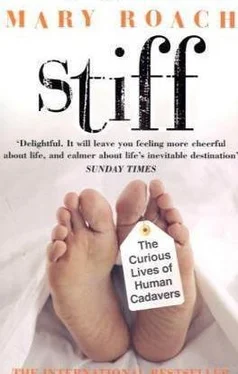Mary Roach - Stiff
Здесь есть возможность читать онлайн «Mary Roach - Stiff» весь текст электронной книги совершенно бесплатно (целиком полную версию без сокращений). В некоторых случаях можно слушать аудио, скачать через торрент в формате fb2 и присутствует краткое содержание. Город: New York, Год выпуска: 2003, ISBN: 2003, Издательство: Viking, Жанр: sci_popular, История, на английском языке. Описание произведения, (предисловие) а так же отзывы посетителей доступны на портале библиотеки ЛибКат.
- Название:Stiff
- Автор:
- Издательство:Viking
- Жанр:
- Год:2003
- Город:New York
- ISBN:0-670-91217-4
- Рейтинг книги:4 / 5. Голосов: 2
-
Избранное:Добавить в избранное
- Отзывы:
-
Ваша оценка:
- 80
- 1
- 2
- 3
- 4
- 5
Stiff: краткое содержание, описание и аннотация
Предлагаем к чтению аннотацию, описание, краткое содержание или предисловие (зависит от того, что написал сам автор книги «Stiff»). Если вы не нашли необходимую информацию о книге — напишите в комментариях, мы постараемся отыскать её.
—
Stiff In this fascinating, ennobling account, Mary Roach visits the good deeds of cadavers over the centuries—from the anatomy labs and human-sourced pharmacies of medieval and nineteenth-century Europe to a human decay research facility in Tennessee, to a plastic surgery practice lab, to a Scandinavian funeral directors’ conference on human composting. In her droll, inimitable voice, Roach tells the engrossing story of our bodies when we are no longer with them.
Stiff — читать онлайн бесплатно полную книгу (весь текст) целиком
Ниже представлен текст книги, разбитый по страницам. Система сохранения места последней прочитанной страницы, позволяет с удобством читать онлайн бесплатно книгу «Stiff», без необходимости каждый раз заново искать на чём Вы остановились. Поставьте закладку, и сможете в любой момент перейти на страницу, на которой закончили чтение.
Интервал:
Закладка:
Utah places clamps on the arteries of H’s heart, stanching the flow of blood in preparation for the cuts. You can tell by the vital signs monitor that something monumental is happening to her body. The ECG has quit drawing barbed wire and begun to look like a toddler’s Etch-a-Sketch scrawls. A quick geyser of blood splashes Utah’s glasses, then subsides. If H weren’t dead, she’d be dying now.
This is the moment, reported the Case Western Reserve group who interviewed transplant professionals, when OR staff have been known to report sensing a “presence” or “spirit” in the room. I try to raise the mental aerial and keep myself open to the vibes. Of course I have no idea how to do this. When I was six, I tried as hard as I could to will my brother’s GI Joe to walk across the room to him. This is how these extrasensory deals go with me: Nothing comes of it, and then I feel stupid for trying.
Here is the deeply unnerving thing: The heart, cut from the chest, keeps beating on its own. Did Poe know this when he wrote “The Tell-Tale Heart”? So animated are these freestanding hearts that surgeons have been known to drop them. “We wash them off and they do just fine,” replied New York heart transplant surgeon Mehmet Oz when I asked him about it. I imagined the heart slipping across the linoleum, the looks exchanged, the rush to retrieve it and clean it off, like a bratwurst that’s rolled off the plate in a restaurant kitchen. I ask about these things, I think, because of a need to make human what otherwise verges on the godlike: taking live organs from bodies and making them live in another body. I also asked whether the surgeons ever set aside the old, damaged hearts of transplant recipients for them to keep. Surprisingly (to me, anyway), only a few express an interest in seeing or keeping their hearts.
Oz told me that a human heart removed from its blood supply can continue beating for as long as a minute or two, until the cells begin to starve from lack of oxygen. It was phenomena like this that threw eighteenth-century medical philosophers into a tizzy: If the soul was in the brain and not the heart, as many believed at that time, how could the heart keep beating outside the body, cut off from the soul?
Robert Whytt was particularly obsessed with the matter. Beginning in 1761, Whytt was the personal physician to His Majesty the King of England, whenever His Majesty traveled north to Scotland, which wasn’t all that often. [30] No matter, for Whytt could have kept his appointment book full with no other patient besides himself. According to R. K. French’s biography of Whytt in the Wellcome Institute of the History of Medicine series, edited by F. N. L. Poynter, M.D., the physician suffered from gout, spastic bowels, “frequent flatulence,” a “disordered stomach,” “wind in the stomach,” nightmares, giddiness, faintness, depression, diabetes, purple discolorations of the thighs and lower legs, coughing fits “producing a thick phlegm,” and, according to two of Whytt’s colleagues, hypochondria. When he died, at the age of fifty-two, he was found to have “some five pounds of fluid, mixed with a substance of gelatinous consistency and bluish color,” in his chest, a “red spot the size of a shilling on the mucous membrane of the stomach,” and concretions in the pancreas. (This is what happens when you put M.D.’s in charge of biographies.)
When he wasn’t busy with His Majesty’s bladder stones and gout, he could be found in his lab, cutting the hearts out of live frogs and chickens and, in one memorable instance that you hope for Whytt’s sake His Majesty never got wind of, dribbling saliva onto the heart of a decapitated pigeon in an attempt to start it up again. Whytt was one of a handful of inquiring medical minds who attempted to use scientific experimentation to pin down the location and properties of the soul. You could see from his chapter on the topic in his 1751 Works that he wasn’t inclined to come down on either side of the heart-versus-brain debate.
The heart couldn’t be the seat of the soul, for when Whytt cut the heart out of an eel, the remainder of the creature was able for some time to move about “with great force.”
The brain also seemed an unlikely home port for the animating spirit, for animals had been observed to get on quite well for a surprising length of time without the benefit of a brain. Whytt wrote of the experiment of a man named Redi, who found that “a land tortoise, whose brain he extracted by a hole made in its skull, in the beginning of November, lived on to the middle of May following.” [31] What was going on in experiments like these? Hard to say. Perhaps the brain stem or spinal medulla had been left intact. Perhaps Dr. Redi, too, had his brain extracted from a hole in his skull the November past.
Whytt himself claimed to have been able, “by the influence of warmth,” to keep the heart of a chick beating in its chest for two hours after its head was “clipped off with a pair of scissors.” And then there was the experiment of a Dr. Kaau. Wrote Whytt: “A young cock whose head Dr. Kaau suddenly cut off… as he was running with great eagerness to his food, went on in a straight line 23 Rhinland feet, and would have gone farther had he not met with an obstacle which stoppt him.” These were trying times for poultry.
Whytt began to suspect that the soul did not have a set resting place in the body, but was instead diffused throughout. So that when you cut off a limb or took out an organ, a portion of the soul came along with it, and would serve to keep it animated for a time. That would explain why the eel’s heart continued beating outside its body. And why, as Whytt wrote, citing a “well-known account,” the “heart of a malefactor, which having been cut out of his body and thrown into the fire, leapt up several times to a considerable height.”
Whytt probably hadn’t heard of chi, but his concept of the ubiquitous soul has much in common with the centuries-old Eastern medical philosophy of circulating life energy. (“Chi” is also spelled “qi.”) Chi is the stuff acupuncturists reroute with needles and unscrupulous healers claim to harness to cure cancer and knock people off their feet in front of TV
cameras. Dozens of scientific studies purporting to document the effects of this circulating life energy have been done in Asia, many of them abstracted in the Qigong Research Database, which I browsed several years ago while researching a story on qi. All across China and Japan, qigong (“gong” means cultivation) healers are standing in labs, passing their palms over petri dishes of tumor cells, ulcer-plagued rats (“distance between rat and palm of hand is 40 cm”), and, in one particularly surreal bit of science, a foot-long section of human intestine. Few of these studies were done with controls, not because the researchers were lax, but because that’s not traditionally how Eastern science is done.
The only Western-style peer-reviewed research attempting to prove the existence of life energy was done by an orthopedic surgeon and biomedical electronics expert named Robert Becker, who became interested in chi following Nixon’s visit to China. Nixon, impressed with what he saw during a visit to a traditional Chinese clinic, had urged the National Institutes of Health to fund some studies. One of them was Becker’s. Operating on the hypothesis that chi might be an electrical current separate from the pulses of the body’s nervous system, Becker set about measuring transmission along some of the body’s acupuncture meridians. Indeed, Becker reported, these lines transmitted current more efficiently.
Some years earlier, New Jersey’s own Thomas Edison came up with another variation on the all-through-the-body concept of the soul. Edison believed that living beings were animated and controlled by “life units,” smaller-than-microscopic entities that inhabited each and every cell and, upon death, evacuated the premises, floated around awhile, and eventually reassembled to animate a new personality—possibly another man, possibly an ocelot or a sea cucumber. Like other scientifically trained but mildly loopy [32] People have trouble believing Thomas Edison to be a loopy individual. I offer as evidence the following passage on human memory, taken from his diaries: “We do not remember. A certain group of our little people do this for us. They live in that part of the brain which has become known as the ‘fold of Broca.’ …There may be twelve or fifteen shifts that change about and are on duty at different times like men in a factory…. Therefore it seems likely that remembering a thing is all a matter of getting in touch with the shift that was on duty when the recording was done.”
soul speculators, Edison strove to prove his theory through experimentation. In his Diary and Sundry Observations , Edison makes references to a set of plans for a “scientific apparatus” designed to communicate with these soullike agglomerations of life units.
Интервал:
Закладка:
Похожие книги на «Stiff»
Представляем Вашему вниманию похожие книги на «Stiff» списком для выбора. Мы отобрали схожую по названию и смыслу литературу в надежде предоставить читателям больше вариантов отыскать новые, интересные, ещё непрочитанные произведения.
Обсуждение, отзывы о книге «Stiff» и просто собственные мнения читателей. Оставьте ваши комментарии, напишите, что Вы думаете о произведении, его смысле или главных героях. Укажите что конкретно понравилось, а что нет, и почему Вы так считаете.












